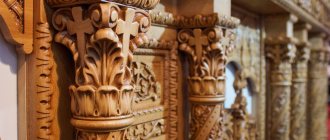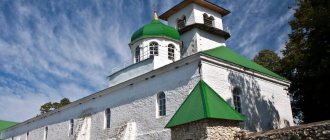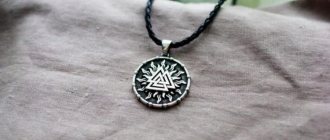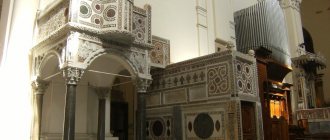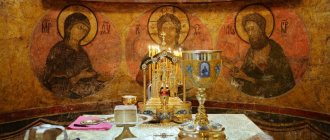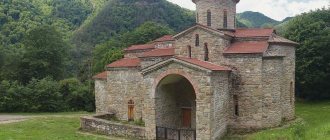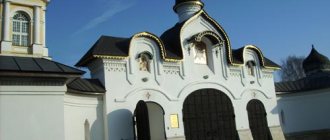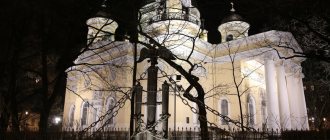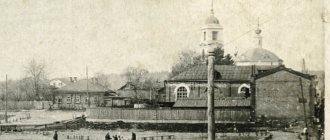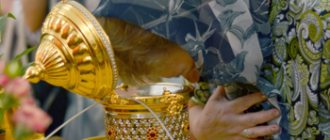Other meanings of this word:
- (trans.) A place that inspires awe
- Elevation in the Temple
- elevated part of a Christian temple
- Eastern elevated part of the Christian temple
- The eastern elevated part of a Christian church (in the Orthodox Church, separated from the general premises by the iconostasis)
- Eastern part of the temple
- The eastern part of the Christian temple, where the throne is located
- Eastern, main part of the temple, in which the throne is located
- Main part of the temple
- The main, eastern part of the Christian church, separated by an altar barrier, and in Orthodox churches by an iconostasis
- The main, eastern part of the church, separated from the common room by the iconostasis
- Altar
- Altar (originally a place for outdoor sacrifices)
- A bride is brought to him in church
- A lamb is being led to the slaughter
- They are leading him to get married
- the bride is brought to him
- a lamb is being led to the slaughter
- where sacrifices are made
- Where are the sacrifices made?
- Place in the temple
- Place in the church
- place for sacrifice, sacred part of the temple
- Place of sacrifice
- The place of sacrifices and gifts to the deity in religious cults
- Place of sacrifice; altar (among ancient peoples)
- Place behind the choir
- place of sacrifice
- the name of this church term comes from the Greek word “altus” - “high”
- the most important part of an Orthodox church for religious ritual, separated from its main space by an altar barrier or iconostasis
- in Latin it is both an eminence and a place of sacrifice
- pedestal for sacrifice
- Pedestal for sacrifice
- throne behind the iconostasis
- Sanctuary
- Sanctuary in the Temple
- Holy place in the temple
- part of a Christian temple
- what's behind the pulpit
- What's behind the pulpit?
- This word comes from the Latin “altus” - high and means an object inherent in most world religions for performing religious rituals. What subject is meant?
Eastern elevated part of the Christian temple.
And when, at a meeting of the house committee, Vartan, going into a rage, began to pound his fist on the podium and loudly say that, if necessary, even his children should be placed on the altar of Greater Armenia, like Abraham his firstborn son, she went and asked, where is the altar of Greater Armenia located, here in Hrazdan, or in Marseille, in France, and if the altar is here, then why is Vartan’s son studying in that Marseille for six months now and not going to return to lie on the altar?
Selfless priests of secular rites in a society with so few altars (there are four churches in Bullet Park), and none of them is considered sacrificial, they have erected a solemn altar on which they constantly lay (and by no means in the figurative sense of the word) a piece of his living flesh, an altar that is irrigated with his own blood.
The altar (in Church Slavonic - altar) was called incense because there was another altar - burnt offerings.
Moreover, the incident with the duleba woman who poked her head into the altar was also made public: Alleluy’s wife, when she began to “lament” loudly over her husband’s grave, publicly revealed the whole secret of her destructive autocracy and shouted to the whole baptized world that her husband Alleluy was a righteous man and he didn’t want to hide the fact that the “duleba” stuck her head into the altar, and she took him away from it, and for that the Lord punished her righteously: he took Hallelujah from her completely to the next world.
The very designation of the sanctuary in Russian usage - “altar” - going back to the lexical function of the Greek noun Fvsiaoshotg designating already in the Septuagint, and later in the Greek language of Byzantine times, both the altar itself and the altar space, makes one think about many things.
Inner Temples usually have a fixed altar made of stone or wood and this altar should be installed in the East.
After all, a Cossack brings to the altar of his fatherland not only his strength, his youth and life, he must appear at this altar fully armed, in full uniform, made at his own expense, with a significant part of the weapons and even with part of the food supply.
Keep in mind that I do not intend to put my personal life on the altar (she said “on the altar”) for your sake.
The carpenters have already made six benches and a massive altar; masons carved patterns on the fence that separated the altar from the main nave; the most experienced stone cutter made a beautiful bowl for holy water from a piece of marble that her uncle Jasper brought from Chester.
The altar is like an altar, the light is burning, black for some reason, the line of petitioners is only smaller than in churches.
Structure and current status
The modern Church of the Holy Sepulcher is an architectural complex that includes Calvary with the site of the Crucifixion, a rotunda (a structure with a dome, under which the Edicule is directly located), the Catholicon (the cathedral of the Orthodox Church of Jerusalem), the underground Church of the Discovery of the Life-Giving Cross, the Church of St. Helen Equal to the Apostles and several chapels. On the territory of the Church of the Holy Sepulcher there are several monasteries, a number of auxiliary premises, galleries, etc.
The temple is divided between six denominations of the Christian Church: Greek Orthodox, Catholic, Armenian, Coptic, Syrian and Ethiopian, each of which has its own chapels and hours for prayer. Thus, the Franciscan Church and the Altar of Nails belong to the Catholic Order of St. Francis, the Church of Equal-to-the-Apostles Helen and the chapel of the “Three Marys” - the Armenian Apostolic Church, the grave of St. Joseph of Arimathea, altar on the western part of the Edicule - Coptic Church. Golgotha and the Catholicon belong to the Jerusalem Orthodox Church. The Edicule is shared by different faiths - the liturgy on the Holy Sepulcher is served one after another by the Orthodox (from 11 to 3 a.m.), Armenians (from 3 to 6 a.m.), then by Catholics (from 6 a.m. to 9 a.m.).
Often this division causes conflicts between representatives of different faiths. To avoid any misunderstandings between different faiths, the keys to the temple have been kept since 1192 by the Arab-Muslim family Joudeh, with the right to unlock and lock the door belonging to another Muslim family, the Nuseibeh. These rights have been passed down from father to son in both families for centuries.
What is hidden in the architecture of an Orthodox church?
Remember we talked about the symbolism of gestures, borrowed in a ready-made form? Color symbolism and entire subjects were similarly borrowed (from both secular and religious pre-Christian art). And all this changed over time, gradually molding into canonical forms...
I hope no one thinks that things were different with architecture?
Ancient architects had several sources for creativity.
Church of Mary Magdalene in Jerusalem Photo: Depositphotos
The first landmark is the Tabernacle of the Covenant, descriptions of which are found both in the Old Testament and in the Antiquities of the Jews by Josephus:
“...was divided lengthwise into three parts... the division of the tabernacle represented in some way the view of the whole world: for the third part, located between the four pillars and inaccessible to the priests themselves, meant in some way Heaven, dedicated to God; a space of twenty cubits, as if representing the earth and sea, over which people have a free path, was determined for the priests alone.”
The third part corresponded to the area, the world of the dead.
Later, the Temple of Jerusalem was built on the model of the tabernacle, which became the model for the New Testament Christian churches.
Cathedral of the Holy Spirit in Minsk Photo: Depositphotos
According to this, the temple is a horizontal projection of the vertical structure of the world: above is Heaven, below is the world of the dead (not yet Christian hell, but Jewish Sheol!), in the middle is the earthly world, people. In the Christian church, this scheme is also deployed horizontally, consisting of three main parts: narthex - naos - altar.
That is why the most ancient Christian churches stretch from west to east.
Another ancient image: a temple as a symbol of a ship. Not just any one, but a very specific one... What is the most famous biblical ship? The one on which humanity was once saved!
Actually, the symbolic “ship” is still present in churches: the longitudinal space of the temple, the central or side longitudinal passages are traditionally called nave, ship. Just keep in mind that initially the most common were elongated temples.
Photo: Depositphotos
Most churches in Russia are cross-domed, that is, they have the shape of an equal cross in plan. Especially small churches where the naves do not give the impression of being elongated.
But this is in Russia, which adopted the already fairly evolved form of the temple from Byzantium and then developed quite independently for a long time. As an example, we can cite the unique Russian iconostasis, which has gone far from its Byzantine prototype.
But we will return to the form of the temple later. Shall we go inside?
The temple begins with a narthex, a vestibule, essentially a “vestibule”, a “gateway” between the external and temple worlds. Here in ancient times there were neophytes who had not yet fully entered into the new teaching and were only preparing to be baptized. And also those who are temporarily excluded from communion, for example, due to penance.
The middle part of the temple is the “world of people,” intended for parishioners. Actually, this is the central nave - the symbolic “ship of salvation”. Those being saved are, of course, church members.
Photo: Depositphotos
But in addition to the “heavenly world,” there is also the “heavenly world.”
The iconostasis was mentioned above... What is its function? After all, the developed iconostasis appeared later, but at first it was a symbolic altar barrier, essentially a low side fence. On which icons do not appear immediately... What does it symbolize?
The barrier, which we are accustomed to perceive as an iconostasis, as a “complex of images,” was originally not intended for beauty and not at all for installing icons on it. In fact, this is the border between the profane and the sacred, the world below and the world above, earth and Heaven.
And just as modern borders of states do not at all represent blank fences (but everyone understands that not everyone can cross them), so everyone who understood the symbolism understood: before you is the line separating “here” from “there”.
Photo: Depositphotos
However, this meaning did not go away when the altar barrier took the form of a developed iconostasis, symbolizing the earthly church. Which is at the same time the only way to God, and the actual barrier that protects the sacred part of the temple, where the uninitiated have no access, which is exhaustively expressed as “there is no Salvation outside the Church.”
So, the eastern part of the temple is a projection of Heaven. Actually, the altar is otherwise called the “Mountain Place”. But it's not that simple.
From under the iconostasis there emerges a solea—an elevation protruding into the middle part of the temple. It seems like a small thing, a step, but there is nothing accidental in the church. Solea is the part of the altar that goes “out into the world.” A symbol of the fact that the two worlds - earthly and heavenly - are not tightly fenced off from each other.
Yes, the iconostasis retains the functions of an altar barrier, still separating the sacred from the profane - that’s why it’s a temple, a place dedicated to God. But it is the earthly church, symbolized by the iconostasis, that is considered in Christianity the only path to Salvation. Thus, the iconostasis becomes not only a barrier, but also a bridge from man to God...
Photo: Depositphotos
What else is a must-have in church? Dome and images on religious themes: icons or frescoes.
As you might guess, the dome symbolizes Heaven. More precisely, not quite a dome. We now often mean by “dome” external domes, crowns, bulbous or helmet-shaped finials. Those that are visible from the outside, about which they say that the church has one, three, five or more domes.
There is some confusion of concepts here. The dome and the head are not always the same thing. From inside the temple we see the vaulted ceiling, the domed vault of the temple. The dome, the pommel, is located on top of the vault, so that we may not see its inner surface at all - and therefore it does not interest us now.
It is customary to paint the walls and the inner surface of the vault.
- In general terms, in the altar niche, the apse, the Communion and the Virgin Mary (in particular, the praying Virgin Mary, Oranta) can be depicted.
- Exactly opposite the altar, on the opposite, western wall, the Last Judgment is depicted.
- Between the altar and the naos is the earthly Church, the iconostasis.
- On the walls are images of saints (in particular, those to whom this temple is dedicated), scenes from their lives and sacred history.
- On the pillars under the dome are martyrs and church fathers, “supporting” the teaching like pillars supporting a vault.
- The evangelists are traditionally located in the sails of the vault.
- Even higher, in the drum (if there is one) are the archangels.
- And in the upper part of the vault is Christ in the image of Pantocrator, the Almighty.
Photo: Depositphotos
What is this? We started with a horizontal structure of the temple, and this is a vertical structure.
Finally, the last thing. With a vertical hierarchy, everything seems to be approximately clear. She goes up, she is above us... And she will always be above us.
The horizontal one is more difficult. Entering the church, we pass from sunset to the east, from the profane to the sacred. During worship, in general in church, we are under the symbolic Heaven. And when we leave, we go back: from the sacred part, from under the Sky-vault-dome, into the world, each time passing by the image of the Last Judgment.
Photo: Depositphotos
And from this point of view, the elongated rectangle of a Catholic church has a more powerful effect. There, a person is forced every time to go through this path from the Last Judgment to the altar, to Salvation. And back. Unlike an Orthodox church, where we almost immediately find ourselves under the dome of Heaven.
In any case, we are probably expected to reflect on this path every time. That visiting church is not limited to receiving communion, attending the liturgy, or participating in the procession of the Cross. Since the church is completely filled with symbols, these symbols are intended specifically for the people who come here.
Tags: Orthodox church, architecture, symbols, temple, Christianity, iconostasis
Temple structure
Main entrance
The facade of the temple from the entrance (i.e. from the south) is an example of Romanesque architecture of the 12th century. The double lunettes of the portal originally contained marble bas-reliefs of the Entry of the Lord into Jerusalem and the Burial of the Savior, which were then transferred to the Rockefeller Museum in Jerusalem. On the right, in front of the entrance to the temple (the right door was blocked under Salah ad-Din), there is a wooden hatch covering the tomb of the knight Philip d'Aubigne, who accompanied the German Emperor Frederick II upon entering Jerusalem in 1229.
Column of the Holy Fire
The Column of the Holy Fire is one of the marble Corinthian columns that form the portal on the left. It was miraculously split almost in half on Holy Saturday 1634. In connection with the disputes that arose about Easter (the Orthodox celebrated Easter that year on April 6, a week earlier than the anti-Chalcedonite Armenians), the Ottoman authorities, at the insistence of the Armenian governor, locked the temple, not allowing the Orthodox to attend the service of the Holy Fire. Through the prayer of Orthodox believers who had gathered at closed doors, led by Metropolitan Parthenius of Bethlehem and Archbishop Athanasius of Gaza (Patriarch Theophan IV was not in Jerusalem at that time), lightning struck from a storm cloud and Holy Fire appeared from a crack in a split column.
In the right, north-eastern corner of the courtyard, an external staircase leads to a small chapel that served as the vestibule of the Calvary chapel. Nowadays it is called the Chapel of Our Lady of Sorrows or the “Chapel of the Franks”, sometimes referred to as the Chapel of the Removal of the Robes in memory of how the Roman soldiers divided among themselves the clothes of the Crucified One. Under the Roman Catholic chapel, on the 1st floor, a separate entrance leads to the Orthodox parecklision of St. Mary of Egypt.
Stone of Anointing
Inside the temple, opposite the entrance, lies the Stone of Anointing, covered with a red polished marble slab 30 cm thick, on the sides of which the Greek text of the troparion to St. Joseph of Arimathea is carved around the perimeter. The corresponding Gospel text (John 19:38-40) is written in Greek on a marble plaque hanging on the right. The removal of the Cross from the Lord, the anointing of the body with incense and the position in the coffin are depicted on a large mosaic panel, stylized as a Byzantine pattern, on the wall directly behind the Stone of Anointing. The mosaic was completed with the blessing of Patriarch Diodorus in 1990 by V. Tsotsonis. Above the Stone there are 8 lamps (4 - Orthodox, 2 - Armenian, 1 - Latin, 1 - Coptic).
There is no evidence reaching us about exactly where the body of the Lord was prepared for burial. But already from the 5th century, the rite of the Burial of the Shroud has been prominent in the observance of Good Friday. In the temple it is performed as follows: the shroud covered with rose petals is transferred by 6 bishops from Golgotha to the Stone of Anointing; after the litany at the Stone, the shroud is solemnly transferred with a threefold litany around the Edicule and placed on the Triday Bed, then taken to the altar of the catholicon.
Edicule
The Chapel of the Holy Sepulcher, or Edicule, stands to the left of the Stone of Anointing, under the arches of the rotunda. On the sides of the entrance to the Edicule there are low marble barriers with benches, behind which there are tall candelabra belonging to the Roman Catholics. Above the door there are lamps hanging in 4 rows (13 each for Orthodox, Roman Catholic and Armenian). One of the decorations of the Edicule is a Russian carved silver canopy from the 1st half of the 19th century with 12 icons of the Holy Apostles using the Rostov enamel technique. In 2004, by order of the Jerusalem Patriarchate, the ancient enamel was replaced with new ones, manufactured using modern technology by the Rostov company A. Rudnik. The Edicule (8.3x5.9 m) consists of 2 parts: western, 6-gonal in plan (2.07x1.93 m), where the Holy Sepulcher is located, and eastern (3.4x3.9 m), where the chapel is located Angela. A pedestal with a part of the sacred stone rolled away by an angel is located in the middle of the chapel and serves as a throne during the celebration of the bishop's Orthodox liturgy at the Holy Sepulcher (in this case the Triday Bed itself becomes the altar). There are 15 lamps in the chapel (in 3 rows, according to the number of main confessions). In the northern and southern walls there are oval windows for the transmission of the Holy Fire on Holy Saturday (northern - for Orthodox, southern - for Armenians). The entrance from the Angel's chapel to the Cave of the Holy Sepulcher is decorated with a marble portal. On the left at the entrance are depicted the myrrh-bearing women, on the right is the Archangel Gabriel stretching out his hand to them (according to the inscription), at the top of the portal is a marble canopy with an inscription in Greek, reproducing the words of the angel: “Why are you looking for the living among the dead? He is not here, He has risen."
Cave of the Holy Sepulcher
The Cave of the Holy Sepulcher is a small chamber, almost half occupied on the right by a stone bed covered with a marble transenna slab. The slab appeared in Kuvuklia in 1555. Maxim Simeos, who was the last to see the Savior’s stone bed without a slab covering it in 1810, testified that it was severely damaged by the unreasonable jealousy of countless “God-lovers” who strove to break off, bite off, and take away a piece of the shrine at any cost. In the western part of the slab, due to the zeal of the pilgrims, a noticeable depression was formed. On the marble shelf running along the sides of the Triday Bed, there are 3 icons of the Resurrection (from each of the Christian confessions). The ktitor inscription above the door names the creator of Edicule - the Greek architect N. Komninos, who was martyred by the Turks in Constantinople on Easter 1821.
Chapel of the Chapter
In the western part, the Chapel of the Head, belonging to the Coptic Church, is attached to the cuvuklia. According to legend, the second angel sat here (“at the head”) (John 20:12). Since Byzantine times, a small throne existed on this site. The Crusaders called the chapel "cavet" ("head" in Norman dialect) because it was located at the head of the Edicule. According to Armenian sources, the chapel was built by the king of Cilician Armenia, Etum II, in 1300. Subsequently, the Armenians gave this chapel to the Copts, receiving in return one of the monasteries in Egypt. In 1810, the Orthodox Greeks reconstructed the Edicule without the Coptic chapel, which was restored 30 years later at the direction of the then ruler of Palestine, Ibrahim Pasha, son of the Egyptian Khedive Muhammad Ali. Coptic monks cite a legend that during the reconstruction of the edicule in 1810, the niche of the Holy Bed was truncated in the western part, so that the place where the head of the Savior rested ended up in the Coptic chapel.
Triumphal Arch
By a low, one-step podium, the Edicule is connected to the Triumphal Arch (or the Arch of Monomakh, named in memory of the Eastern Roman Emperor Constantine IX Monomakh, who restored the temple in 1048) and the Church of the Resurrection that opens behind it. The lintel under the arch contains an inscription in Greek on the side of the katholikon: “Rejoice, O Zion, Holy Mother of the Churches of God!” In the passage of the arch there are small balconies on the left and right, facing the Edicule, on which, until 1917, consuls and other honorary representatives of the main Orthodox powers - Russia and Greece - were located during ceremonial services.
Church of the Resurrection of the Lord (Katholikon)
Previously, the temple complex of the Holy Sepulcher consisted of several separate sanctuaries: a rotunda directly containing the Edicule, Calvary (Orthodox and Roman Catholic) chapels and the cathedral church of the Jerusalem Orthodox Patriarchate. The Crusader Basilica united these objects in a single internal space. Nowadays, the “middle” volume of the temple complex, enclosed by special walls that do not reach the vaults, built after the fire of 1808, is called the katholikon (cathedral church) of the Resurrection of the Lord. The Greek reconstruction of that time changed the composition of the structure: in addition to the side walls, a high iconostasis appeared. From a liturgical point of view, the unity of the temple space was achieved, and the necessary prayerful atmosphere for Orthodox worship was created. The dome of the katholikon, the smaller of the 2 domes of the temple, is located above the western part. Exactly under the dome, on a special vase-stand, a marble hemisphere is placed, indicating a place called “mesomphalos” - “the navel of the Earth.” The idea of Jerusalem as the center of the earth and the economy of salvation has been known since ancient times (Ps 73:12), but this building appeared in the temple no earlier than 1810. The dome contains a mosaic image of Christ the Pantocrator blessing him, surrounded by the Mother of God, St. John the Baptist, Archangels Michael and Gabriel, and 12 saints. Between the 8 windows of the drum, in the niches, there are images of seraphim and cherubim. The mosaic work in the dome of the katholikon was completed in 1994.
The Catholicon is the cathedral of the Patriarchate of Jerusalem, which is why there are 2 throne seats in its eastern part - the thrones of the Patriarch of Jerusalem at the southern pillar and his representative, the Metropolitan of Petro-Arabia, at the northern one. Above the iconostasis is a gallery with 3 pulpits (small balconies) protruding into the church, from where, according to the ancient Byzantine rule, the deacon should read the Gospel. The entire eastern part of the catholicon, including the iconostasis, the sole with 4 steps, 6 columns on it, the northern and southern entrances to the altar, is a single ensemble of pink marble.
Underground temples
The underground church of St. Helena now belongs to the Armenians, who acquired it, according to one version, from the Georgian Orthodox community, according to another, from the Ethiopians. The temple has 2 altars: the northern altar is dedicated to the Prudent Thief; the main, central one - to Queen Saint Helena and her contemporary Saint Gregory the Illuminator. According to Armenian legend, when Saint Gregory, after a long feat of prayer, came to venerate the Holy Sepulcher, he was honored by the descent of the Holy Fire. The small cross-domed temple (20x13 m) was originally the crypt of the basilica of Emperor Constantine. The dome in the center is supported by 4 ancient monolithic columns; the vaults were erected no earlier than the 12th century. The plane of the floor between the columns is covered with mosaics with scenes from the history of Armenia. A special niche and stone seat mark the place in the temple behind the altar dedicated to Saint Helena, where the queen sat during the excavations. There are 3 unquenchable lamps burning in the window.
The Church of St. Helena is connected by 13 steps to the Roman Catholic Church of the Finding of the Cross, located at the lowest point of the entire temple complex. Behind the stone throne stands on a high pedestal a large bronze statue of St. Helena with the Cross she found in her hands, donated by the Austrian Archduke Maximilian. In the right corner of the chapel, under a low-hanging rock, lies a small marble slab with a white 8-pointed Orthodox cross on a black background, marking the place where the Honest Tree was discovered. The Cave of the Finding, according to A. A. Dmitrievsky at the beginning of the 20th century, “is now the almost undivided property of Catholics, but back in 1835 the Greek throne stood here.” On the Feast of the Exaltation, the Orthodox clergy, led by the Patriarch, performed a solemn litany called the parousia: the procession of the cross left the southern doors of the catholicon and passed through the outpatient clinic to the stairs of the Temple of Helena. Then the procession descended into the Cave of the Finding, where the troparion of the holiday was performed and the Patriarch performed the rite of the Exaltation of the Cross in 4 places - at the ends of the imaginary Cross. Then the procession headed to the Edicule and, having walked around it three times, ascended to Golgotha, where the rite of the Exaltation of the Cross was repeated. To the left of the Orthodox slab at the site of the Finding of the Cross, from a hole in the wall one can hear, according to the pilgrims, “a hellish buzzing.” “In essence, this phenomenon occurs because opposite this excavation there is a huge, now empty cistern under the temple.” In 1970, with the blessing of the Armenian Patriarch, the space to the northeast of the apse of the Church of St. Helena was explored. We discovered a room to which access had been closed since ancient times. This newly found part of the temple was named the Chapel of St. Vardan the General or Armenian Warrior Martyrs with a passage from the Church of St. Helena. In the center of the chapel there is an altar with a khachkar in the name of 1036 Armenian martyrs who died during the Armenian-Persian War in 451.
Calvary
The most important place of worship in the entire Church of the Holy Sepulcher is the Church of Golgotha, which contains the site of Christ's crucifixion. Golgotha acquired its modern architectural appearance as a result of the renovation of the temple in 1810. At the holy place of the Crucifixion there is only the rock itself, which builders and restorers of different eras truncated, leveled, and hewn; today its dimensions are 4.5x11.5x9.25 m. There are 2 staircases leading to the rock: the right one starts immediately from the doors of the temple (“Latin rise” leads to the Roman Catholic side chapel), the left one - from the side of the catholicon (“Greek rise” leads to main Orthodox chapel). 2 naves, separated by squat massive pillars with an arch between them, form the Orthodox and Catholic side chapels of Calvary, which in Byzantine times they formed a single temple.
The Orthodox throne, one meter high, is made of pink marble; under the throne there is a hole into which the Crucifixion was placed. The surface of the rock is hidden by a marble floor; only to the right and left of the throne in the glazed openings can one see the gray stone of Golgotha itself and the crack that passed through the entire rock as a result of the earthquake at the time of the Savior’s death (Matt. 27:51).
The southern aisle of the Church of Calvary - Nailing to the Cross - belongs to the Roman Catholic Franciscans. It acquired its modern appearance as a result of restoration in the late 1930s according to the design of A. Barluzzi, after the 1927 earthquake. From the mosaics of the Crusader period, only a fragment of the composition “The Ascension of Christ” on the vault of the central arch has survived. The silver altar (master D. Portigiani from the monastery of San Marco in Florence) was donated to the temple in 1588 by the Grand Duke of Tuscany Ferdinando de' Medici. It is believed that the altar was placed on the spot where the hands and feet of the Savior were nailed to the Cross. It was originally intended for the Stone of Anointing, which explains its elongated shape, but due to friction between denominations, the Franciscans were forced to place it in the chapel of the Church of Calvary.
Under the arch separating the Roman Catholic part of Calvary from the Orthodox, there is a Roman Catholic altar “Stabat Mater” (according to the first words of the prayer of the 14th century Italian Franciscan poet Jacopone da Todi). Behind the throne is a sculpture of the Blessed Virgin with a sword in her chest in accordance with the prediction of Simeon the God-Receiver (Luke 2:35) (the sculpture was donated by the Portuguese Queen Maria I of Braganza and brought to Jerusalem from Lisbon in 1778).
Under the rock of the Crucifixion there is a chapel of the head of Adam, otherwise known as the chapel of Melchizedek, who, according to legend, buried the head of the progenitor of the human race here. From here you can see a chasm in Golgotha about 15 cm wide.
From this chapel, the door on the right leads to the office-cell of the epitrope of the temple (the former chapel of St. John the Baptist), from where you can go to the Orthodox sacristy, where a cross-reliquary with a particle of the Life-Giving Tree and many particles of the relics of saints are kept.
Based on materials from azbyka.ru
